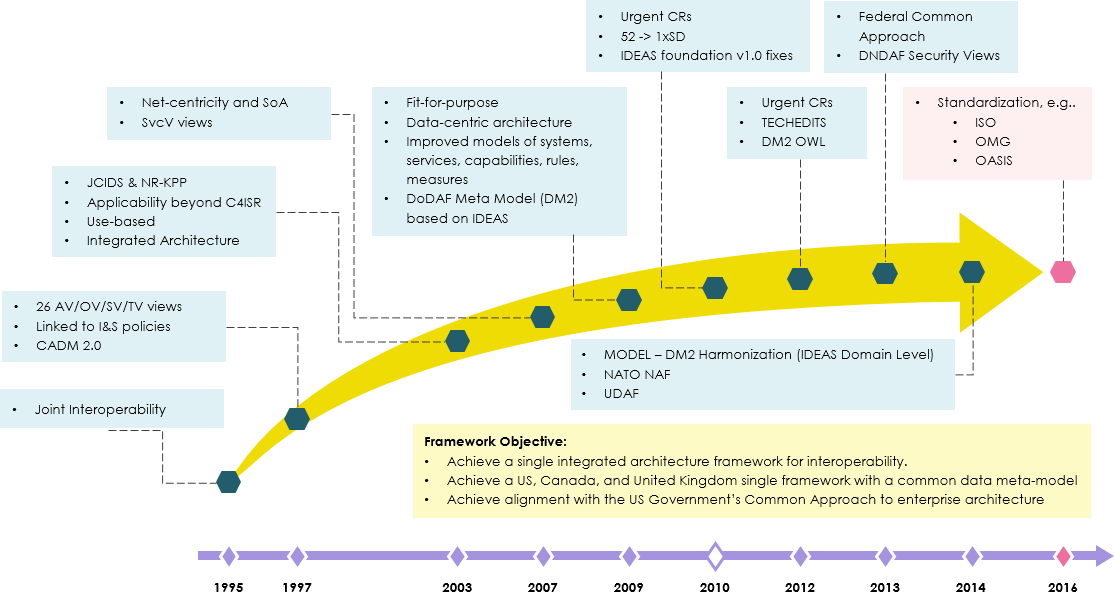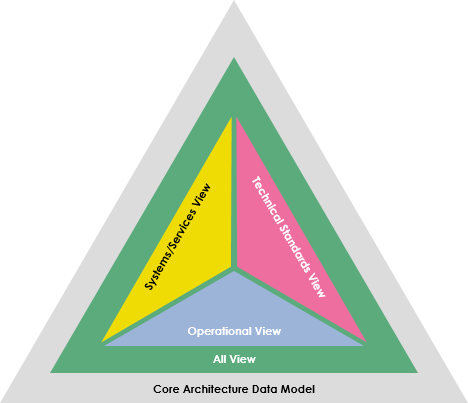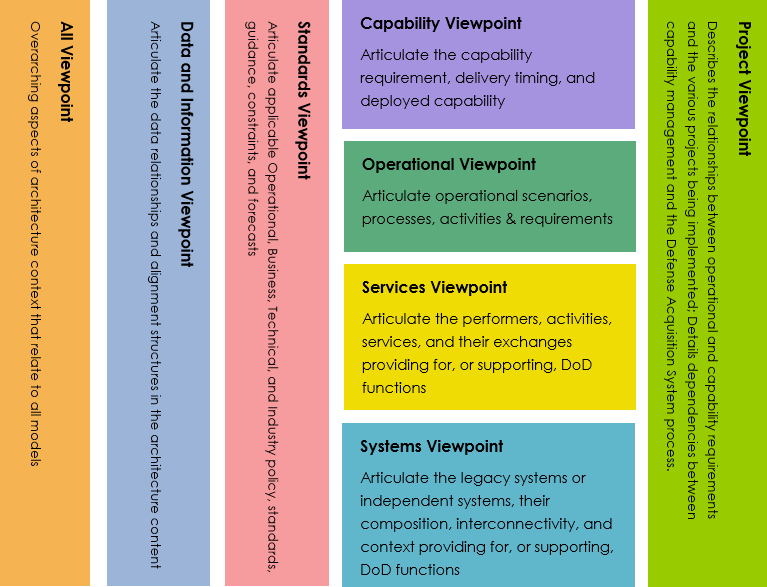The Department of Defense Architecture Framework (DoDAF) defines a common approach for presenting, describing and comparing DoD enterprise architectures across organizational, joint or multinational boundaries. It also promotes the use of common terminology, assumptions, and principles to facilitate integration better. Thus, DoDAF is especially suited to large systems with complex integration and interoperability challenges, and it is unique in its employment of “operational views”. These views offer overview and details aimed at specific stakeholders within their domain and in interaction with other domains in which the system will operate.
DoDAF provides visualization infrastructure for specific stakeholders’ concerns through viewpoints organized by various views. These views are artifacts for visualizing, understanding and assimilating the broad scope and complexities of an architecture description through tabular, structural, behavioral, ontological, pictorial, temporal, graphical, probabilistic, or alternative conceptual means.
DoDAF helps System Architects, Systems Engineers, Software Developers, and others who seek to transition from traditional systems development processes that are document-based and code-centric, to Model-Based Engineering processes that are requirements-driven and architecture-centric.
All major U.S. DoD weapons and information technology system acquisitions are required to develop and document an enterprise architecture (EA) using the views prescribed in the DoDAF. While it is aimed at military systems, DoDAF has broad applicability across the private, public and voluntary sectors around the world, and represents one of a large number of systems architecture frameworks.
As the enterprise architecture framework of choice for defense /aerospace applications, DoDAF is a key enabling technology for organizing and sharing large, complex system architectures for distributed Systems-of-Systems (cf. Network Centric Operational Warfare architectures).
The purpose of DoDAF is to define concepts and models usable in DoD’s six core processes:[6]
The objective of DoDAF is to concretely define models and concepts that are usable in the DoD’s six core processes:

The current version as of this writing is 2.02 and it had the following specific goals:
DoDAF is a large complete EA framework, but if I summarize it in brief here:

In Version 2.0 they added the

Capability Viewpoint (CV) gets the enterprise goals related to the entire vision for executing a specified course of action
Operational Viewpoint (OV) encapsulates the organizations, tasks, and information that must be communicated between them to accomplish DoDAF goal.
Services Viewpoint (SvcV) captures system, service, and interconnection functionality providing for, or supporting, operational activities.
Systems Viewpoint (SV) captures the information on supporting automated systems, interconnectivity, and other systems functionality in support of operating activities.
Project Viewpoint (PV) explains the way by which programs are grouped in organizational terms as an articulated portfolio.
Standards Viewpoint (StdV) is the minimal set of rules governing the arrangement, interaction, and interdependence of system parts or elements.
Data and Information Viewpoint (DIV) captures the business information requirements and structural business process rules for the Architectural Description.
All Viewpoint (AV) models provide information pertinent to the entire Architectural Description.
| Operational Viewpoint | Systems Viewpoint | Services Viewpoint | All Viewpoint | Standards Viewpoint | Data & Information Viewpoint | |
| AV-1 | AV-1 | |||||
| AV-2 | AV-2 | |||||
| OV-1 | OV-1 | |||||
| OV-2 | OV-2 | |||||
| OV-3 | OV-3 | |||||
| OV-4 | OV-4 | |||||
| OV-5 | OV-5a, OV-5b | |||||
| OV-6a | OV-6a | |||||
| OV-6b | OV-6b | |||||
| OV-6c | OV-6c | |||||
| OV-7 | DIV-2 | |||||
| SV-1 | SV-1 | SvcV-1 | ||||
| SV-2 | SV-2 | SvcV-2 | ||||
| SV-3 | SV-3 | SvcV-3a, SvcV-3b | ||||
| SV-4a | SV-4 | |||||
| SV-4b | SvcV-4 | |||||
| SV-5a | SV-5a | |||||
| SV-5b | SV-5b | |||||
| SV-5c | SvcV-5 | |||||
| SV-6 | SV-6 | SvcV-6 | ||||
| SV-7 | SV-7 | SvcV-7 | ||||
| SV-8 | SV-8 | SvcV-8 | ||||
| SV-9 | SV-9 | SvcV-9 | ||||
| SV-10a | SV-10a | SvcV-10a | ||||
| SV-10b | SV-10b | SvcV-10b | ||||
| SV-10c | SV-10c | SvcV-10c | ||||
| SV-11 | ||||||
| TV-1 | StdV-1 | DIV-3 | ||||
| TV-2 | StdV-2 |
Visual Paradigm provides an easy-to-use, model-driven DoDAF software that supports the development of DoDAF 2.02 views and models. Create integrated DoDAF products with traceability maintained among views. Generate architectural documents that facilitate organizations to efficiently coordinate enterprise architecture initiatives.
